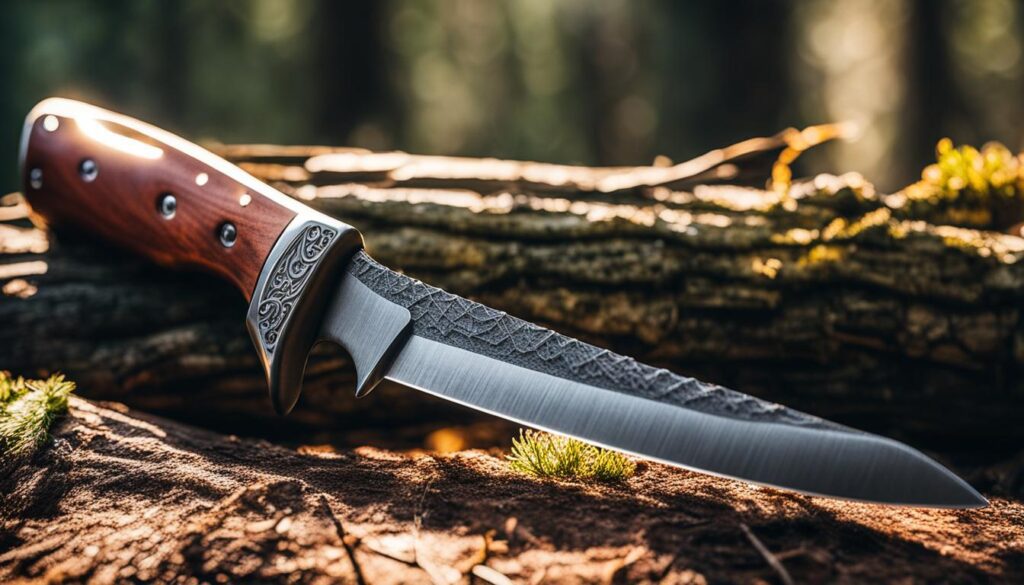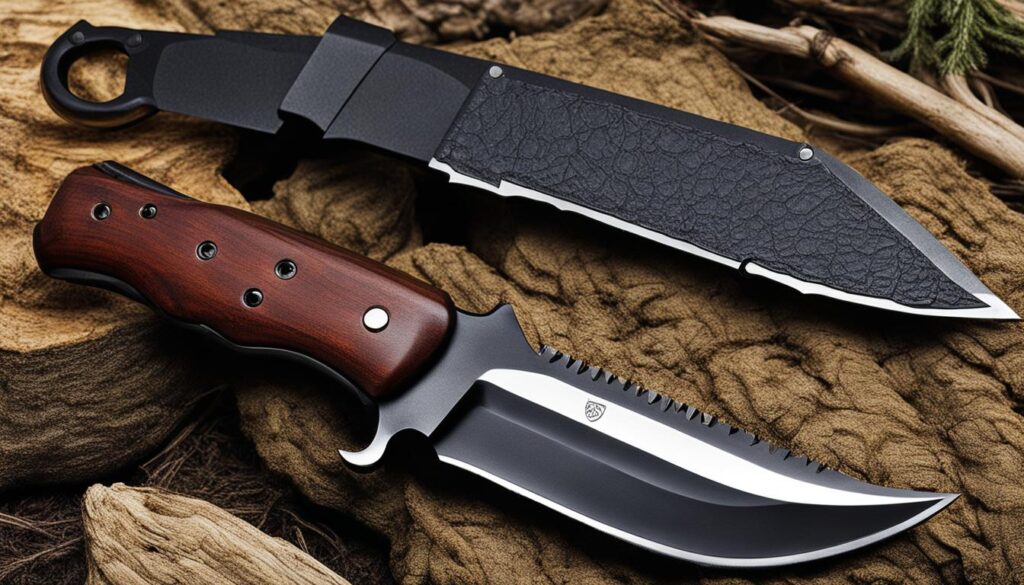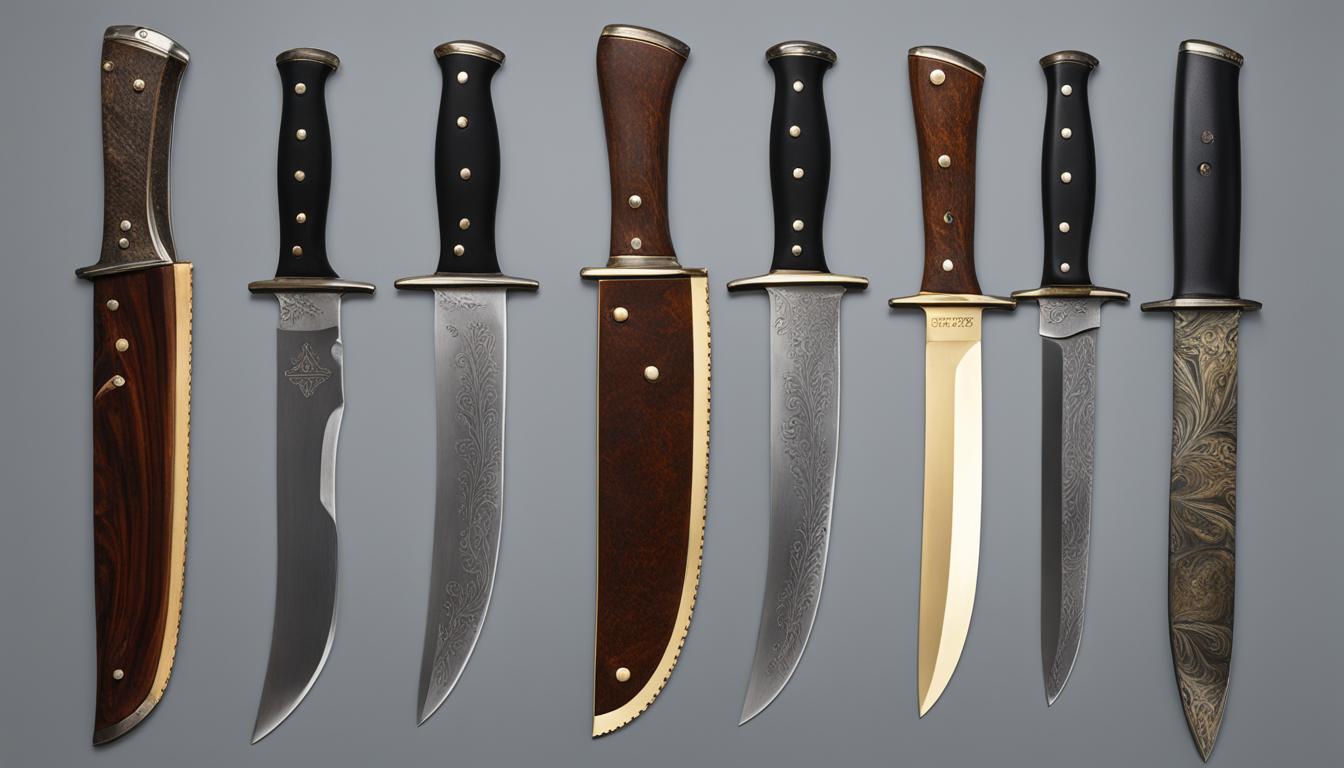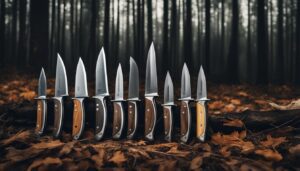When it comes to selecting the perfect hunting knife, one of the most important factors to consider is the blade length. The blade length not only affects the knife’s versatility but also its suitability for specific tasks. Whether you are a seasoned hunter or a beginner, understanding the significance of blade length variation is essential for making an informed decision.
Short hunting knives:
Short hunting knives, typically with blade lengths between 3 to 4 inches, are recommended for tasks like dressing whitetail deer. The shorter blade length allows for more control and precision when dressing the deer, making the process easier and more manageable.
Versatile option:
If you are unsure about the game you will be hunting or the tasks you will be performing, a hunting knife with a 4-inch blade length is a versatile choice. It provides a balance between maneuverability and functionality, making it suitable for a wide range of hunting activities.
Fixed blades vs. folding blades:
Fixed blade knives are generally stronger and easier to clean, making them a popular choice among hunters. Folding blades, on the other hand, offer convenience and compactness, making them ideal for those who value portability. Consider your preferences and the specific demands of your hunting adventures when deciding between fixed blades and folding blades.
Gut hooks:
While not essential, gut hooks can be a convenient feature for field dressing game. Gut hooks allow for easier and more precise opening of the animal’s body cavity during dressing. If you often find yourself field dressing game, consider a hunting knife with a gut hook.
When choosing the perfect hunting knife blade length, take into account the specific game you will be hunting and the tasks you will be performing. Consider the balance between control, functionality, and versatility to ensure that your hunting knife meets your needs.
Key Takeaways:
- Blade length plays a crucial role in determining the suitability of a hunting knife for different tasks.
- For dressing whitetail deer, a blade length between 3 to 4 inches is recommended.
- A 4-inch blade offers versatility for various hunting activities.
- Fixed blades are stronger and easier to clean, while folding blades offer convenience and portability.
- Gut hooks can be a convenient feature for field dressing game but are not essential.
The Different Types of Hunting Knife Blades
Hunting knives come in various blade shapes, each with its own advantages. Understanding the different types of hunting knife blades can help you make an informed decision when selecting the perfect knife for your needs.
Clip Point Blade
The Clip Point blade is characterized by a straight spine and a clipped tip. This blade shape provides better balance and tip control, making it suitable for precise tasks such as skinning and puncturing. The clipped tip allows for easier insertion into tight spaces, making it a versatile choice for hunters.
Drop Point Blade
The Drop Point blade is known for its versatility and functionality. With a slightly curved spine, the Drop Point blade positions the tip below the spine, resulting in improved control and puncturing capabilities. This blade shape is ideal for tasks that require strength, such as dressing game and general outdoor use.
Trailing Point Blade
The Trailing Point blade features a curved spine that positions the tip above the spine. This blade shape is specifically designed for skinning animals with tightly attached hides, allowing for precise and efficient skinning. The elongated belly of the Trailing Point blade also maximizes cutting surface area, making it an excellent choice for field dressing game.
Consider your specific tasks and preferences when choosing the perfect hunting knife blade shape. Whether you need a blade for skinning, puncturing, or general outdoor use, selecting the right blade shape is essential for optimal performance.
Factors to Consider When Choosing a Hunting Knife
When selecting a hunting knife, it is important to consider several factors that will determine its suitability for your needs. These factors include the purpose of the knife, its size and weight, the blade material, handle material, and your budget.
1. Purpose
First and foremost, determine the primary purpose of the hunting knife. Are you mainly using it for field dressing game, skinning animals, or performing other specific tasks? Understanding the main purpose will help you choose the appropriate blade length, shape, and features.
2. Size and Weight
The size and weight of the hunting knife are crucial considerations for both comfort and functionality. You want a knife that feels balanced in your hand and is easy to maneuver. Consider the size of your hand and the tasks you will be performing to determine the optimal size and weight for your needs.
3. Blade Material
Blade material plays a significant role in the performance and durability of a hunting knife. Common blade materials include stainless steel and high-carbon steel. Stainless steel is known for its corrosion resistance and ease of maintenance, while high-carbon steel offers exceptional sharpness and edge retention. Choose a blade material that suits your preferences and the intended use of the knife.
4. Handle Material
The handle material of a hunting knife affects its grip, comfort, and durability. Common handle materials include wood, rubber, and synthetic materials like G10 or Micarta. Consider the ergonomics of the handle and choose a material that provides a secure and comfortable grip, even in wet or slippery conditions.
5. Budget
Finally, establish a budget for your hunting knife. Hunting knives can vary significantly in price, depending on the brand, materials used, and additional features. Consider how much you are willing to invest in a high-quality hunting knife that meets your specific needs and preferences.
By taking these factors into consideration, you can choose the perfect hunting knife that aligns with your intended use, feels comfortable in your hand, and meets your budget requirements.
The Best Hunting Knife for Outdoor Adventures
When it comes to outdoor adventures, having the right hunting knife can make all the difference. Whether you’re hunting, surviving in the wilderness, or simply enjoying a camping trip, choosing the right knife is essential. There are several types of hunting knives that cater to different outdoor activities, ensuring you have the right tool for the job.

“A good hunting knife is a reliable companion in outdoor adventures, and choosing the right one can greatly impact your experience. The key is to understand the different types of knives available and their specific uses.”
One of the most popular types of hunting knives is the fixed-blade knife. Known for their sturdiness and reliability, fixed-blade knives are ideal for hunting and demanding tasks. They offer a strong and durable blade that can handle heavy-duty cutting and field dressing game.
Table: Types of Hunting Knives
| Knife Type | Best For |
|---|---|
| Fixed-blade knife | Hunting and heavy-duty tasks |
| Survival knife | Outdoor survival and various activities |
| Folding knife | Everyday use and light outdoor tasks |
| EDC knife | Lightweight and versatile for a range of tasks |
| Multi-tool knife | Combines a knife with other essential tools |
| Fishing knife | Cleaning and preparing fish |
| Fillet knife | Precision filleting and seafood preparation |
For those who prioritize portability and convenience, folding knives are an excellent choice. These knives are compact, making them perfect for everyday use and light outdoor tasks. They easily fit in your pocket or backpack without taking up much space.
EDC (Everyday Carry) knives are lightweight and versatile, suitable for a wide range of daily tasks. From opening packages to cutting rope, an EDC knife can come in handy in various situations. They are designed to be easily carried and readily available whenever you need them.
If you’re looking for a multifunctional tool, a multi-tool knife is the way to go. These knives combine a blade with other essential tools like screwdrivers, bottle openers, and saw blades. They provide a complete solution for campers, hikers, and outdoor enthusiasts who want to be prepared for any situation.
Lastly, fishing knives, particularly fillet knives, are designed specifically for cleaning and preparing fish. They feature a thin, flexible blade that allows for precision filleting and seafood preparation. If you enjoy fishing as part of your outdoor adventures, a fillet knife is a must-have tool.
Consider your specific outdoor activities and needs when choosing the best hunting knife. Whether you opt for a fixed-blade knife, survival knife, folding knife, EDC knife, multi-tool knife, fishing knife, or fillet knife, selecting the right tool will enhance your outdoor experience and ensure you’re prepared for whatever comes your way.
Tips for Selecting the Perfect Survival Knife
When it comes to choosing the perfect survival knife, there are several factors to consider. Beyond the blade length and type, there are additional steps you can take to enhance your knife skills and knowledge. Here are some tips to help you make the most of your survival knife:
- Attend outdoor survival courses or knife skills workshops: Participating in these educational opportunities can provide valuable insights and hands-on experience. You’ll learn essential techniques, gain confidence, and discover new ways to utilize your survival knife in various outdoor scenarios.
- Engage with the knife community: Joining online forums or social media groups dedicated to knives can broaden your knowledge. You can connect with experienced enthusiasts who are eager to share their expertise, answer questions, and provide support.
- Explore customization options: Personalize your survival knife by exploring customization options. This can include adding unique handle materials, engraving, or modifying the sheath. Customization not only adds a personal touch but also increases the bond between you and your knife.
- Expand your collection: As your interests and skills evolve, consider expanding your knife collection. Different types of knives serve specific purposes, and having a diverse selection allows you to be prepared for various situations. Consider adding specialized knives such as a bushcraft knife, a utility knife, or a tactical knife to your collection.
By following these tips, you can develop your knife skills, connect with like-minded individuals, and ensure you have the perfect survival knife for your outdoor adventures.


Knife Community Testimonial
“Engaging with the knife community has been invaluable in my journey as a survivalist. I’ve learned new techniques, discovered innovative gear, and made lifelong connections. The collective knowledge and support of the knife community have enriched my outdoor experiences and made me a better outdoorsman.” – James, avid survivalist
Comparison Table: Features of Different Survival Knives
| Knife Type | Blade Length | Handle Material | Special Features |
|---|---|---|---|
| Fixed Blade Survival Knife | 4-6 inches | Durable materials like G-10, Micarta | Full tang construction, pommel for hammering |
| Folding Survival Knife | 3-4 inches (folded) | Lightweight materials like aluminum, carbon fiber | One-handed opening, lock mechanism for security |
| Multitool Survival Knife | Various blade sizes | Stainless steel or titanium | Includes additional tools like pliers, screwdrivers |
Choosing the right survival knife is a personal decision, and it’s essential to find one that meets your specific needs and preferences. By taking the time to develop your skills, engage with the knife community, and explore customization options, you can enhance your outdoor experience and have the perfect survival knife by your side.
Proper Maintenance and Care for Your Hunting Knife
Proper maintenance and care are crucial for ensuring the longevity and optimal performance of your hunting knife. By following a few simple steps, you can keep your knife in excellent condition for years to come.
Cleaning: After each use, thoroughly clean your hunting knife to remove dirt, debris, and moisture. Use mild soap and warm water, and avoid harsh cleaners or abrasive materials that can damage the blade or handle. Dry the knife completely to prevent rust or corrosion.
Sharpening: Regularly sharpen your knife to maintain its sharpness and cutting edge. Use a sharpening stone or honing rod to remove any dullness or nicks on the blade. Follow the manufacturer’s instructions or seek professional guidance for the best sharpening technique.
Lubrication: Apply a small amount of lubricant, such as knife oil or silicone spray, to the moving parts of folding knives. This will ensure smooth operation and prevent rust or corrosion. Avoid using excessive lubricant as it may attract dirt or debris.
Storage: When not in use, store your hunting knife in a dry and cool environment. Avoid storing it in sheaths or leather cases for extended periods as they may retain moisture. Consider using a knife block, sheath with moisture-wicking properties, or a dedicated knife storage case.
Routine Inspection: Regularly inspect your hunting knife for any signs of wear, damage, or rust. Check the blade, handle, and locking mechanisms (for folding knives) to ensure they are in good working condition. If you notice any issues, address them promptly to prevent further damage.
| Maintenance Steps | Description |
|---|---|
| Cleaning | Thoroughly clean your hunting knife after each use using mild soap and warm water. |
| Sharpening | Regularly sharpen the blade using a sharpening stone or honing rod to maintain its cutting edge. |
| Lubrication | Apply a small amount of lubricant to the moving parts of folding knives for smooth operation. |
| Storage | Store your hunting knife in a dry and cool environment to avoid moisture retention. |
| Routine Inspection | Regularly inspect your knife for wear, damage, or rust and address any issues promptly. |
Remember, proper maintenance and care are essential to ensure the longevity and performance of your hunting knife. By incorporating these practices into your routine, you can keep your knife in top condition, ready for any outdoor adventure.
The History and Evolution of Knives
Knives have a rich history that dates back to ancient times. They were one of the earliest and most essential tools developed by humans, enabling them to shape materials and butcher game for survival. The early beginnings of knives can be traced back to simple tools made from rocks, which gradually evolved to include sharper edges and more sophisticated designs.
The history of knives is closely intertwined with the development of blade materials. In the early days, stone blades were commonly used due to their durability and sharpness. However, as humans discovered new materials, such as copper and bronze, they began crafting blades from these metals, which offered superior strength and cutting capabilities. The craftsmanship involved in creating knives advanced as well, with intricate designs and patterns becoming more prevalent.
Innovation played a significant role in the evolution of knives. As civilizations advanced, so did the techniques and technologies used to create knives. The introduction of iron and steel revolutionized the blade industry, providing even greater strength and sharpness. Advancements in metalworking allowed for the production of blades with increased hardness and improved edge retention. Today, modern knives are made from a variety of high-quality materials, including stainless steel and high-carbon steel, which offer excellent performance and durability.
Texan Knives is a leading provider of high-quality knives that embody the history and evolution of this essential tool. With a focus on craftsmanship, innovation, and superior materials, Texan Knives has established a reputation for producing top-notch blades that meet the needs of hunters, outdoor enthusiasts, and collectors alike. Whether you’re in search of a hunting knife, survival knife, or everyday carry (EDC) knife, Texan Knives offers a diverse range of options to choose from.
Conclusion
When it comes to choosing the perfect hunting knife, the blade length is a crucial factor to consider. The length of the blade directly affects its suitability for different tasks, such as dressing game. For whitetail deer, a recommended blade length is between 3 to 4 inches as longer blades can make the process more challenging. However, if you are uncertain about the game you will be hunting, a 4-inch blade offers versatility.
Blade selection goes beyond just the length. Blade shape and material also play important roles in determining the suitability of a hunting knife. Consider the specific tasks you will be performing and choose a blade shape that aligns with your needs. Additionally, pay attention to the material of the blade, as different materials offer distinct advantages.
Proper maintenance and care are paramount to ensure the longevity and optimal performance of your hunting knife. After each use, thoroughly clean the knife to remove dirt, debris, and moisture. Regular sharpening will help maintain the blade’s edge, and lubrication of the moving parts in folding knives will ensure smooth operation. Store your knife in a dry, cool environment and regularly inspect it for any signs of wear, damage, or rust.
Texan Knives offers a wide selection of high-quality hunting knives to meet your needs. With the right blade length, selection, and maintenance, you can fully enjoy the benefits of a perfect hunting knife. Make sure to consider these factors while choosing your hunting knife, and entrust Texan Knives for your outdoor adventures.
FAQ
What is the recommended blade length for a hunting knife?
For whitetail deer, a blade length between 3 to 4 inches is recommended. A 4-inch blade is a versatile option if you are unsure of the game you will be hunting.
Are fixed blade knives better than folding knives?
Fixed blade knives are generally stronger and easier to clean, while folding knives offer convenience and compactness.
Are gut hooks necessary on a hunting knife?
Gut hooks are not essential but can be a convenient feature for field dressing game.
What are the advantages of different blade shapes?
The Clip Point blade offers better balance and tip control. The Drop Point blade provides improved control and puncturing capabilities. The Trailing Point blade is ideal for skinning animals with tightly attached hides.
How should I choose a hunting knife?
Consider the primary purpose, blade length and type, size and weight, blade material, handle material, and budget when choosing a hunting knife.
What are the different types of hunting knives?
There are fixed-blade knives, survival knives, folding knives, EDC knives, multi-tool knives, and fishing knives designed for different outdoor activities.
How can I enhance my knife skills and knowledge?
Consider attending knife skills workshops or outdoor survival courses, engage with the knife community, customize your survival knife, and expand your collection with different types of knives.
How should I maintain and care for my hunting knife?
Clean the knife thoroughly after each use, regularly sharpen the blade, lubricate the moving parts of folding knives, store the knife in a dry and cool environment, and regularly inspect it for wear, damage, or rust.
What is the history of knives?
Knives have been essential tools since ancient times, evolving with different materials, craftsmanship, and designs.





